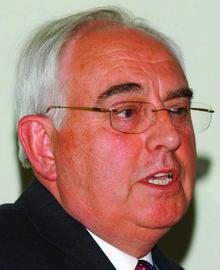New CIBSE president Donald Leeper calls on Whitehall to reclaim its internal procurement expertise
At his inaugural presidential address, Donald Leeper had a clear message for government: if you are serious about improving the outcome of the construction industry, not least the carbon emissions of buildings, you first need to become an expert client.
Drawing on the fact that central and local government collectively procures about 40% of the construction industry’s output, Leeper said the past 20 years had seen it throw away its internal resources as an informed client through moves such as the abolition of the Property Services Agency and the closure of the Department of Health’s technical expert centre in Euston. “Government largely abandoned its opportunities for internal informed technical guidance and feedback. Then it delegated the public sector procurement role even further to individual schools and hospitals groups, so more and more projects were in effect procured by first time clients,” he said. “It needs to become an expert client, perhaps by using the positive aspects of the PSA model.”
Leeper’s address pulled together many of the challenges facing the industry, namely skills shortages, sustainability and climate change. The new president also made a point of highlighting the rise in adversarialism over the past 40 years between clients, contractors, suppliers and consultants which, he said, had had a detrimental impact on the industry and resulted in a deterioration of relationships. “It is not much more than 15 years ago that we risked being sacked if we attempted to build a relationship with key suppliers and incorporate their products into works. More recently this has been totally reversed. As designers we are exhorted to work closely with key suppliers, but too often these suppliers are still underbid later when orders are finally placed.”
The answer to a lot of these issues is developing a foundation of trust, Leeper said. “Many organisations have not yet fully realised that developing trust is potentially a powerful source of competitive advantage; that being adversarial with suppliers and partners consumes more resources for less benefit than taking a proactive commercial approach based on trust. I know this works: I have proved it in our practice over more than two decades.”
Partnering, in relationships and processes, had also not achieved anything like its potential, Leeper said. The obstacles he listed included: more onerous partnering contract clauses; the blurring of responsibility boundaries, with joint and several liability for the whole project required for each key supply chain member; the continuing insistence on retentions; the occurrence of risk dumping, even when the risk is beyond the influence of the supply partner to manage; and designers playing elaborate games of musical chairs as they are sought after for their specialist skills by a number of contractors and consortiums.
Leeper said one-off clients should be encouraged to look more closely at successfully completed projects, what further improvements were envisaged and how many key supply partners had been retained. Lead contractors/consortiums might look at how closely their longer term objectives aligned with short-term pressures of their middle ranking negotiators and managers. “Above all, we in the services sector might reflect that, if we believe being adversarial with suppliers and partners consumes more resources for less benefit, then we have not been successful at convincing our partners higher up the chain.”
On the potential for collaboration between industry institutions, Leeper said: “There has been speculation in the media recently on the need for a major regrouping of the professional bodies into a small number of larger institutions, but much less emphasis on why this is desirable, or what it would achieve. For me it is far more helpful to seek consensus on desired outcomes and how these might be progressed, rather than assume without evidence that one big body would better fulfil our Royal Charter.”
However, by working in collaboration, Leeper said the built environment institutions could offer a single voice to the government. “Six presidents and chief executives all giving the same message to Lord Sainsbury, as they did recently, are every bit as powerful as the head of one large body might be. It’s the widespread buy-in to the message that is important and for which I will work during my year.”
Source
Building Sustainable Design























No comments yet